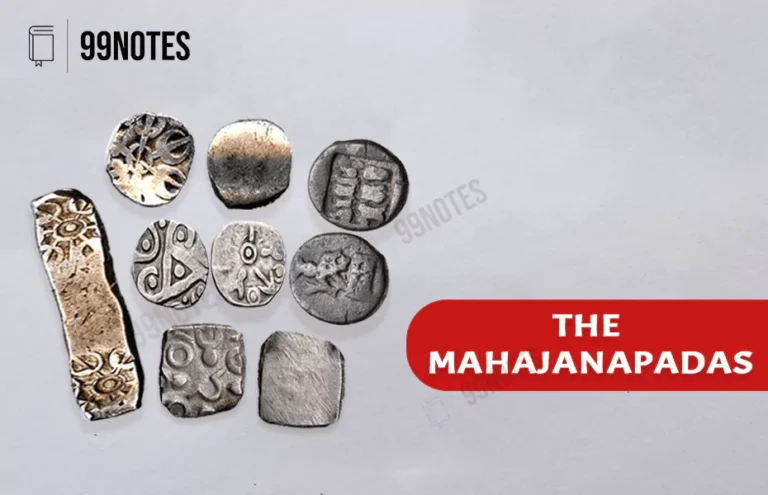Modern Paintings
After the advent of the Europeans in India, new progressions in the field of painting took place. Indian art had always been abstract. Artists who came along British, helped Europeans form a perception about India. They brought with them the idea of realism.
After the advent of the Europeans, we not only see the idea of realism spreading in the Indian art, we also see a rise of debate about which art is superior? And what does it really mean for an art to be Indian.
In this chapter, we shall study the European paintings in India and then its impact on the Indian paintings.
European Paintings
Features of European Paintings
- Methods: The Europeans introduced oil painting and pencil sketching in India that enabled artists to produce image that looked real.
- Subjects: The subjects they painted were varied, but invariably they seemed to emphasise the superiority of British culture, people and power. These included
- Surface: Use of Canvas and paper.
Various traditions were followed in these paintings.
Picturesque:
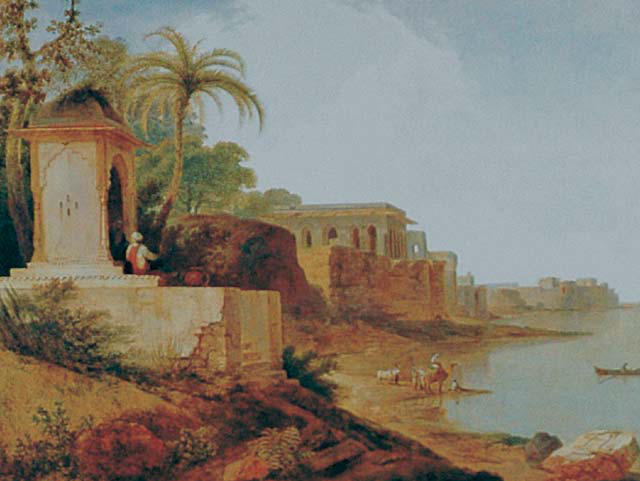
Picturesque is a Landscape painting. The Picturesque that were painted in these times depicted India as an attractive but old-fashioned land, to be explored by travelling British artists.
Thomas Daniell and his nephew William Daniell were the most famous oil painters of this tradition. They came to India in 1785 and stayed for 7 years, journeying from Calcutta to northern and southern India.
Engravings:
Often these painters looked for mass producing these arts. One such method of mass production was engraving.
Engravings is printing method in which a picture is engraved onto a piece of wood or metal into which the drawing has been cut. This cut-out is then stamped on a paper to produce pictures.
Often such “engravings” were eagerly brought up by British pubic to know about Britain’s empire.
Portraiture
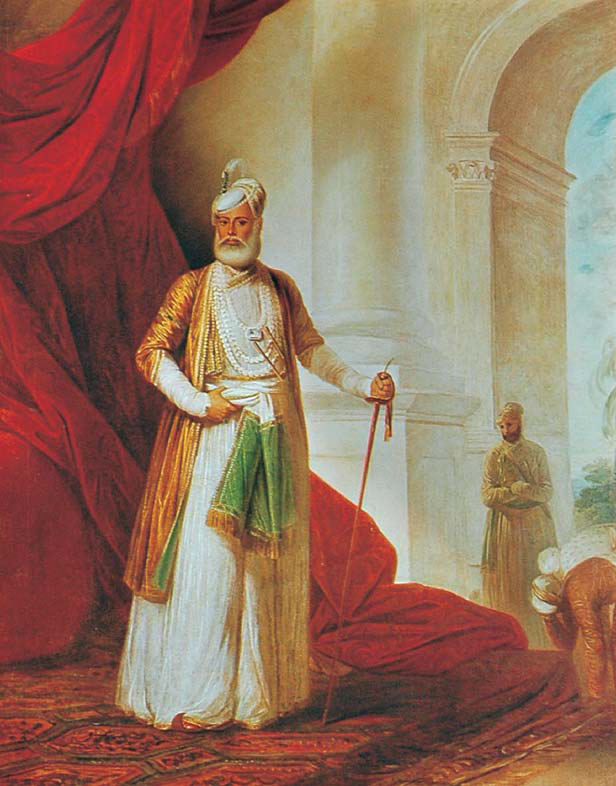
Portraiture were life-size images which were ideal for displaying wealth, lifestyle, status and authority. These were immensely popular amongst rich and powerful, both British and Indians who wanted to see themselves on Canvas. Earlier such images were commissioned as miniature but were kept in personal records.
It was for the first time that life-size portraits were commissioned by the Indian Nawabs and kings, who began employing even European painters, considering European styles and tastes superior to their own.
Muhammad Ali Khan, the Nawab of Arcot became a dependent pensioner after defeat in war in 1770. He commissioned two visiting European artists, Tilly Kettle and George Willison and gifted these painting to King of England and Directors of East India Company.
| Commission Painting |
| A Commission painting is a custom in which a client formally chooses a painter to do a special work against payment. Most of these paintings were Portraitures.
Many European portrait painters came to India from the 18th century in search of profitable commissions. For example, Johann Zoffany, born in Germany, migrated to England and then came to India in mid-1780s for five years. |
History Paintings:
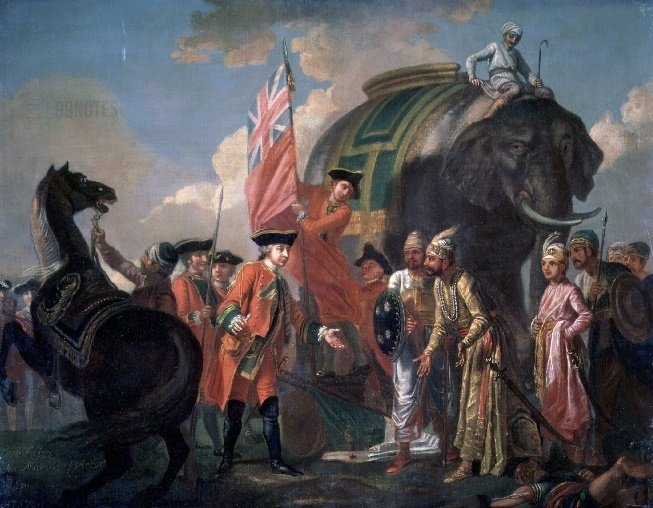
Often the British artists sought to dramatize and recreate various episodes of British Imperial history; It enjoyed great prestige and popularity during the late 18th and 19th century. Painters depicted British actions in India, in a favourable image in British public, displaying their powers, victories and supremacy.
- Francis Hayman, 1762, painted Battle of Plassey; This painting shows Lord Clive being welcomed by Mir Jafar, Nawab of Murshidabad after Battle of Plassey. In the painting Mir Jafar’s conspiracy is not depicted;
- Rober Kerr Porter, 1800, painted the Storming of Seringapatam; In this painting, British military is shown as storming the Tipu’s fort from all sides, cutting Tipu’s soldiers to pieces, climbing the walls, and raising British flag aloft on ramparts of Tipu’s fort.
Erosion of Earlier traditions
The British Raj brought poverty for the local and court Artists. In the previous chapter, we saw that several painters had to migrate to regional kingdoms once the royal patronage from the Mughals died. Some Indian rulers continued their royal patronage.
- Tipu Sultan continued to encourage local traditions, and had the walls of his palace covered with Mural paintings done by local artists. One of them depicting Battle of Polilur of 1780 in which Tipu and Haider Ali defeated English troops.
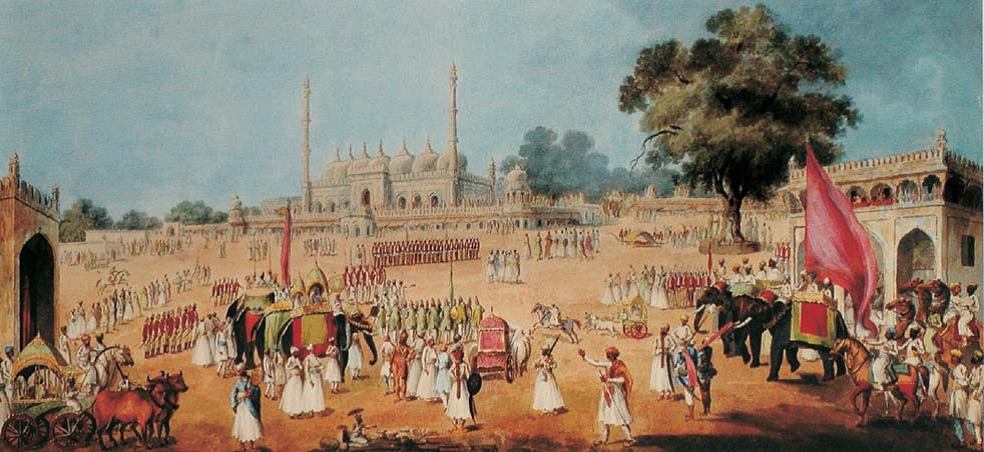
- In Murshidabad, the puppet Nawab continued the patronage of the but they were now heavily influenced by the British styles. They now used perspective and used light and shade to make the figures look lifelike and real.
Local Paintings:
Most Indian courts couldn’t afford artists; Thus, local painters started producing their own images, and started selling them privately.
Company Paintings:
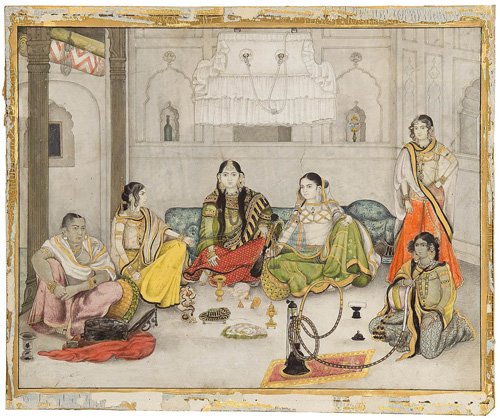
Local painter produced vast number of images of local plants, animals, historical buildings and monuments, festivals and processions, trades and crafts, castes and communities. These were eagerly collected by British officials and came to be known as Company paintings or the Company style.
British officials wanted to collect pictures with which they could remember their lives in India.
Such paintings first emerged in Murshidabad and then in other major cities like Calcutta, Madras, Varanasi, Delhi, Lucknow, Thanjavur etc.
Bazaar Paintings:
Often middle-class Indian artists set up printing presses and produced prints for wide market. They were trained in British art schools in new methods of life study, oil painting and print making.
Kalighat Painting:
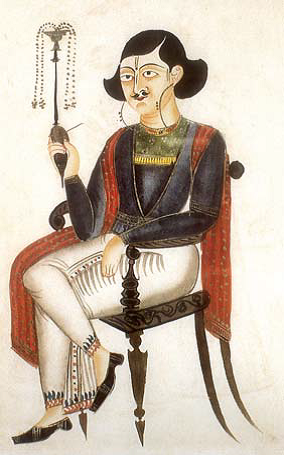
It developed around pilgrimage centre of the temple of Kalighat, local village scroll painters and potters (Kumors in East India and Kumhars in west), began new style of art.
We have seen in the previous chapter that before 19th century, Patua Painters (scroll painters) worked on mythological themes and produced images of gods and goddesses.
On Shifting to Kalighat, they continued to paint these religious images, but introduced a few new elements:
- They started giving shading to give them a rounded form, to make the images look 3-D. Yet were not realistic or lifelike. In fact, specially used bold, deliberately non-realistic style, where the figures emerge large and powerful, with minimum of lines, details and colours.
- Social Themes: In 1840s, Kalighat painters responded to world around them, produced on social and political themes. Often, they mocked at the changes they saw around them, ridiculed the new tasted of those who spoke in English and adopted western habits, dressed like sahibs, smoked sigarettes, or sat on chairs. Made fun of westernised baboo, criticizing corrupt priest and warned against women moving out of homes. They often expressed anger of a common man.

19Th Century Goddess Kali In Kalighat Painting - Engravings: Often Kalighat pictures were engraved on wooden blocks. This created a rough woodcut prints when pressed against the paper, these were further coloured by hand. This way many paintings were produced using same block;
- Portraits and Landscapes: Kalighat painters started making Picturesque and Portraitures. However, these were based on the mythological themes. For example, in many homes in India people paste paintings of gods and goddesses at their homes. These started becoming popular during this period.
By late 19th cent. Mechanical printing presses were set up in different parts of India. Larger number of prints were possible and could be sold at cheaper price in Market.
Search for India’s National Art
Late 19th century and early 20th century was also a time when people started rediscovering India. The Idea of swadeshi and Nationalism emerged. The artists too wanted to rediscover Indian art.
Raja Ravi Verma:
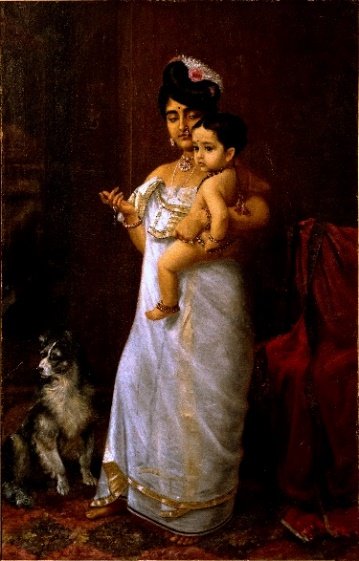
Raja Ravi Verma Mastered western art of oil painting and realistic art study, but painted on themes from Indian mythology. He tried to create a style that was both modern and national.
He was born into an aristocratic family, closely associated with the Travancore kingdom. He learned painting in Madurai and then learned oil painting by a British Portraitist. Later, his painting got widespread acclaim once he exhibited them in Vienna and then in Chicago where he won three gold medals.
He was awarded the title of Raja by Lord Curzon in 1904 and awarded the Kaiser-i-Hind Gold medal on behalf of the British emperor.
Themes Adopted by Raja Ravi Verma:
- Mythological Stories: He dramatized on canvas, scenes from Ramayana and Mahabharata (theatrical performances of mythological stories).
- Portraits of Gods and Goddesses: His Hindu Godesses were based on Indian women whom he considered beautiful. For example, he drew goddess Lakshami and Saraswati.
- Themes from Mundane life: For Example, there comes papa.
His paintings became rage among Indian princes and art collectors, who filled their palace galleries with his works.
With huge popular appeal, he decided to set up a picture production team and printing press on outskirts of Bombay. Here colour prints of his paintings were mass produced. Even poor could buy these cheap prints.
Criticism of Raja Ravi Varma’s Art by Abhanindranath Tagore
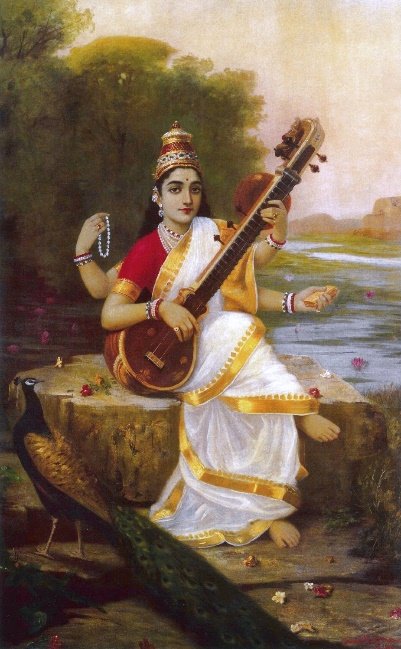
Abhanindranath Tagore is known as the father of Bengal School of Art. He was the nephew of Rabindranath Tagore, and was influenced by the nationalist movements and its ideals.
- He rejected Ravi Varma as imitative and westernized.
- He declared that such a style was unsuitable for depicting the nation’s ancient myths and legend.
Genuine Indian style of painting had to draw inspiration form non-western art traditions and try to capture spiritual essence of East.
Bengal school of Art
Abhanindranath Tagore founded the Bengal School of art which led to the Modern Indian Painting. His aim was to counter the Art taught in the schools under British Raj. In this regard he took following steps:
- He turned for inspiration to miniature painting traditions, mainly Mughal and Rajput Paintings.

Banished Yaksha - Studied ancient art of Ajanta caves.
- They were also influenced by Japanese artists who visited India at that time to develop an Asian art movement.
Major Themes:
- Nationalistic themes: Such as Bharat Mata.
- Mythological themes: For example, the Banished Yaksha of Kalidas’s poem, my mother by Abanindranath, and Jatugriha Daha (burning house of Lac during Pandava’s exile in forest) by his student Nandalal Bose.
- Indian local tales and ballards.
- Asian themes: He painted the Arabian night series of paintings.
| Did you know? |
| The artwork in the original text of the Indian constitution was done by Nandalal Bose, along with his team. He was one of the prominent students of Abanindranath Tagore and who was a major figure in Bengal School of Art. |
FAQs related to Modern Paintings










